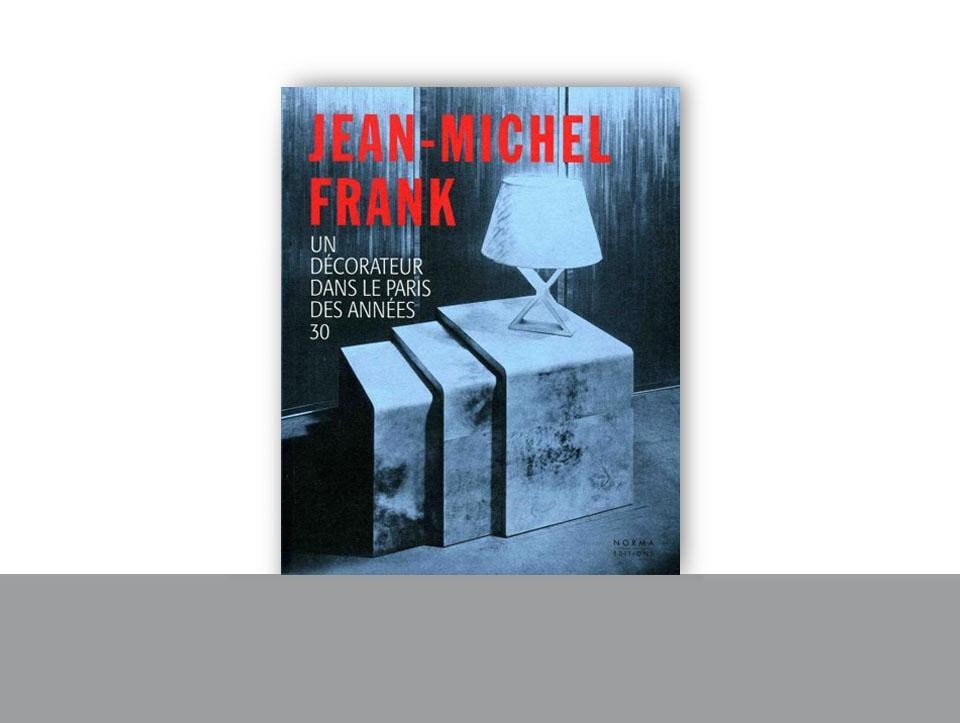Sous la direction de Pierre-Emmanuel Martin-Vivier Norma Éditions, Paris 2009 (pp. 140 s.i.p.)
Drawing its readers in and almost leading them by the hand, this catalogue written by several authors celebrates an exhibition organised by the Fondation Bergé/Saint Laurent in Paris, open until January 2010.
With its changes of colour and pace, the book's graphic design sets itself apart from the pompous celebration typical of so many monographs. Thus we are introduced to quite a "special" person, who also did a lot of scene changing before his premature, self-inflicted demise in 1941. Jean-Michel Frank would be hard to explain had he not lived in France during the interwar years, where the traditionalist cream of the nobility met up with the experimental avant-gardes. Frank was the epitome of the decorator, carrying forward a tradition at least 200 years old that revisited Percier and Fontaine and all the king Louises of France with a lightness that was uncommon in the rest of French Art Deco. His soft modernisation moved between the poles of archaism and anonymity, although surrealism did knock at the door, and who could resist such an irresistible humanisation of the object?
While he cultivated a somewhat neutral receptacle, lining it with parchment, straw, gold-leaf or pickled oak panelling almost to make it disappear, he also created a minimal interior tone that offered the perfect backdrop to a fanciful new surrealist piece that would light up the stage in a different manner. On one hand he was a designer, when he worked on the surrounding walls and revisited the more "basic" pieces of furniture. But on the other he was an entrepreneur (or publisher or smallscale manufacturer), when he wanted to boost the modernist drive, leaving the lion's share of the attention to Dalí, Giacometti and Christian Bérard, who joined his team one after the other. His public showcase was a shop in Rue Faubourg Saint-Honoré, opened in 1935 and closed in 1939. In its two symmetrical windows, slender console tables clad with sharkskin might find themselves supporting large industrial metal floodlights, creating minor contrasts of modernity that placed him far from Le Corbusier and equally distant from the worlds of decorative arts à la Ruhlmann and Leleu. On his very personal journey, his point of reference was on the level of the extraordinary, with extraordinary patrons such as the viscounts of Noailles, and their hotel particulier overflowing with Rubenses, Goyas and Balthuses, the extraordinary and unbridled Marie Laure, a tireless sponsor of interdisciplinary performances, and extraordinary clients such as Elsa Schiaparelli, Nelson Rockefeller, Jean-Pierre Guerlain and the Argentinian agriculture and food industrialist Jorge Born.
Frank did not really want the interior to represent itself in the first person (with a resulting iconic reduction that some saw as early minimalism). Instead, he wanted it to portray a poetic that was the product of an intellectual circle, a congregation of several minds with a single manufacturing spirit. Without the contribution of several sensitivities, and without a symphony that allowed and fostered contrast, there would yet again have been a visible risk of lapsing into "style".
There was no style, therefore, but a subtle intention to place the focus on the Matisses, Légers and Picassos in the New York Rockefeller apartment (1939), where acajou panelling conceals cupboards and shelves in the curves of a rounded rectangle. Rather than style there is a drastic annihilation of furniture in the fixed interior panelling of the Artaud lounge (1936) in Paris, where the white on white of the room's walls is bolstered by a minimal geometric relief (and an ensuing squared furnishing design). In 1939, Frank said goodbye to Paris for racial reasons and headed for New York, then Buenos Aires in 1940, before returning to New York the following year. There, deraciné and forced to live in the western hemisphere with no hope of repeating the environment of Paris, which by then he saw as historically unique, he decided to throw himself from a skyscraper. Manolo De Giorgi


